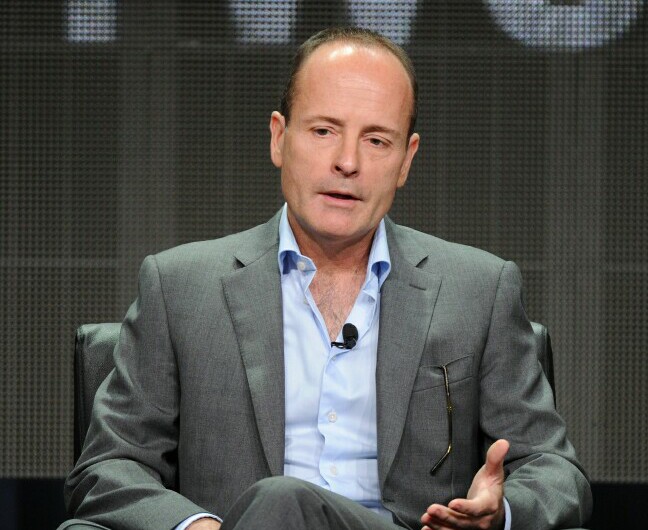FX’s John Landgraf Tells TCA There is “Too Much Television”

With the possible exception of CBS President and Chief Executive Officer Leslie Moonves, who rarely appears on stage at Television Critics Association tours, no network or network group president does them better than FX Networks Chief Executive Officer John Landgraf (pictured above). As he has been known to do in the past, he ensured that his session Friday would yield the biggest headline of the entire event to date: There is too much television. Side note: Landgraf’s session was the 100th press conference of this tour … making its success all the more impressive.
“Over the past few years our research team has provided data which puts into perspective the rapidly increasing amount of original scripted television programming,” Landgraf told critics, reporters and bloggers at the start of FX Networks’ day. (Read about FX Networks' massive presence at the tour.) “We constantly update our scripted series chart and we revised the total for 2014, which we gave you at the January press tour, upward from 352 to 371 original scripted series. By our best current estimates, we believe 2015 will easily blow through the 400 series mark.” In terms of scripted shows, Netflix, FX and HBO are in the lead, he noted.
“I’m asked when and if this proliferation of scripted series will level out and/or even decline,” he continued. “But just when I think we are at that point, another network jumps into the scripted game. I long ago lost the ability to keep track of every scripted TV series. This year, I lost the ability to keep track of every programmer who is in the scripted programming business.
“As you critics know better than anyone in America, this is simply too much television.
“My sense is that 2015 or 2016 will represent peak TV in America and that we’ll begin to see declines coming the year after that and beyond,” Landgraf predicted. “For programmers, this bubble has created a huge challenge in finding compelling original stories and the level of talent needed to sustain those stories. It has also had an enormous impact on everyone’s ability to cut through the clutter and create real buzz. What we are starting to see is a new frontier that will be defined by … brands. And while those brands may have different identities or missions, programmers without a defining brand and the scale to support that brand with great and plentiful programming and marketing are going to have a huge struggle as time goes on.
“A brand is a mission statement, a promise to viewers, a contention that people watch shows, not networks,” he explained. “But as technology evolves and people consume television through different modes of delivery than channels, brands will become increasingly important as mediating filters for the overwhelmed viewing public. That’s no different than what happens in a grocery store. If you went to a grocery store and there were no trusted brand names on the products, you would waste hours of your time trying to figure out what to buy. So brands make consumers’ lives easier. They are sign posts that point to their favorite choices.
“FX Networks is a brand that our viewers love and trust. They know we try to live by our moniker, ‘Fearless,’ and to stand for quality, critically acclaimed, award winning, risk taking scripted programming. HBO, Showtime, AMC, Netflix and a handful of others are meaningful brands, as well. And, yes, Fox, ABC, CBS, PBS, and NBC, too, are potent brands that will survive the transition. There are going to be many modifications to all of our businesses and strategies over the next [few] years, but I believe you will see this brand effect take greater shape in the next 5, 10, 15 years.”
The “‘peak” Landgraf spoke of and the eventual decline will come about because of three things, he later said.
“One is that the denominator is increasing. If you simply take a fixed audience and divide it by 400 plus shows as opposed to 280 shows, it stands to reason that, for most of these shows, ratings will go down. I would say the denominator also increased by virtue of the fact that subscription VOD and on-demand services have now taken every great episode of nearly every television show ever made and made them available at all times to the audience. So that’s one.
“Two is that you’re actually seeing a transformation in the mode that people use to access television. It used to be entirely a cable box and a channel guide. Probably 90 percent of it still comes through that, but an increasing amount is coming through an app, essentially, or a subscription video on demand service, so the very way that consumers consume television is changing, and that’s putting a lot of pressure on linear channels and linear ratings.
“The third factor is that the viewership is spreading out chronologically over time. So if we went back 20 years, we would say that nearly all of the viewership of the television show would occur the first night it went on the air. Now the viewership of the television show is not only spread out across the DVR in Live+3 and Live+7; we sometimes now look at Live+28 data. But it’s spread out in VOD beyond that, and it’s spread in subscription video on demand and transactional, like iTunes, even beyond that.
“With all of this spreading out, to be honest with you, the ability to make revenue off a television show is challenged,” he said. “When you have a large, very thriving portfolio of television, the way HBO does or the way we do or the way Netflix does in a different context, you can manage your way through that.
“When I took over running FX, 55 percent of our revenue was advertising,” he recalled. “It’s 32 percent of our revenue this year, and I’m forecasting it will go down 1 percent every year, so it will be 31 next year, 30 the year after that. Our content ownership revenue was zero when I took over. It’s 12 percent now. What that’s trying to do is capture some of the value of that chronological spread of audience. So it’s just tougher than it was. And I guess what I would say is I think you see in the late stages of a bubble this kind of desperate scrum, where everyone is trying to jockey for position in the sense that we’re playing a game of musical chairs, and they’re going to start to take chairs away, and we want to get a seat.”
The advertising model is, Landgraf later said, “pretty broken right now” and “has to be reinvented.” But he doesn’t think it is going to go away. “Any of you who watch a lot of TV would say that watching television on Netflix or HBO with no commercial interruption and watching that versus watching a show on our linear channel [that is] interrupted by twenty commercials or promos in an hour [is a very different experience] from a consumer standpoint.
“But I don’t think the advertising business is going to go away. There’s a lot of really interesting innovation around targeted advertising and things that could go on in the on-demand and the VOD space, and it won’t be twenty ads [per hour]. It will be maybe one ad, or [viewers will] get the opportunity to say [they will] engage with one ad now and watch the show commercial free, or start watching it commercial free and pause it any time and then be interrupted by a commercial.
“Essentially right now there’s so much advertising its effectiveness is kind of disappearing a little bit into the ether,” Landgrf concluded. “Once we get those models made, that will allow us to recapture the economic value.”


